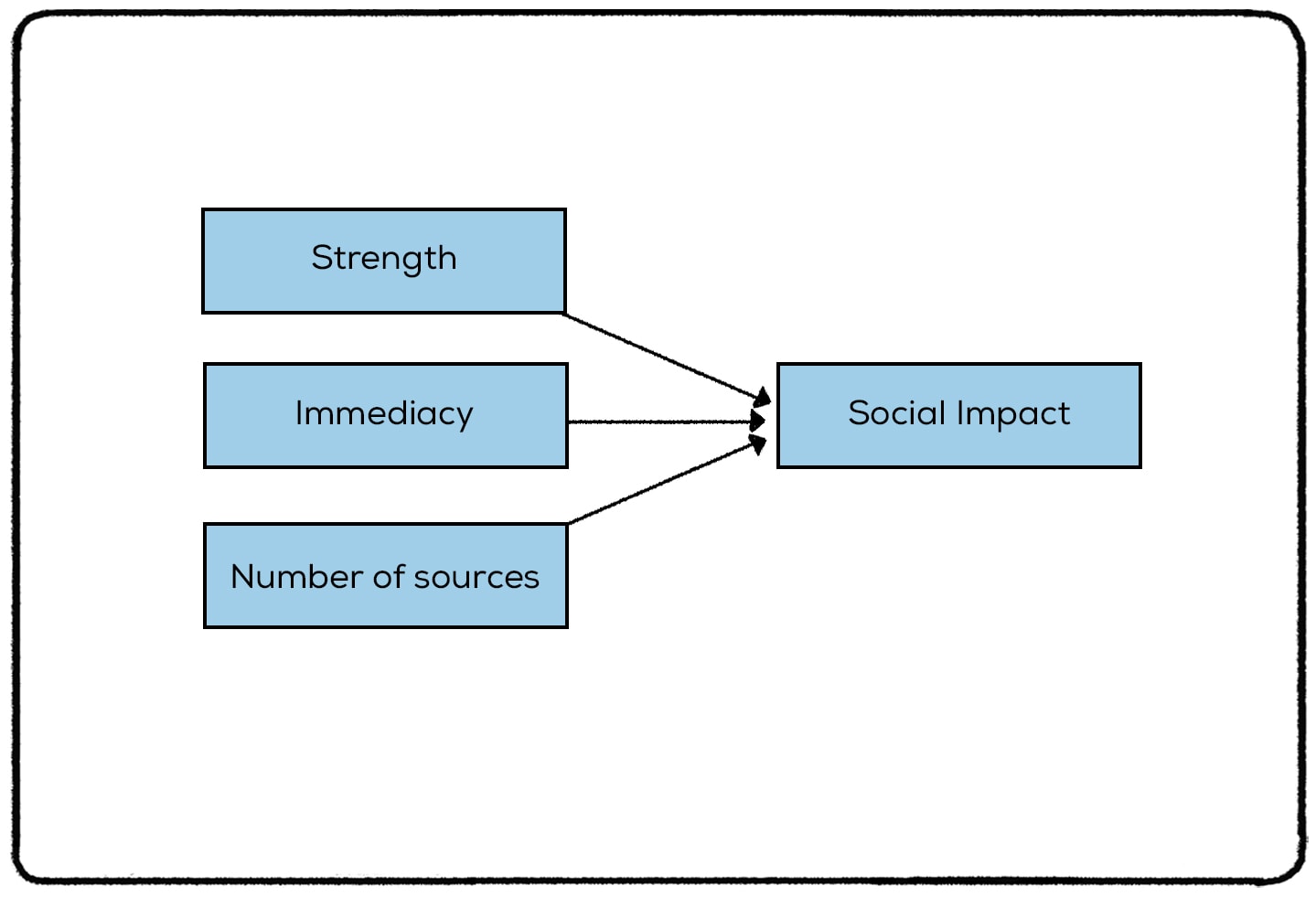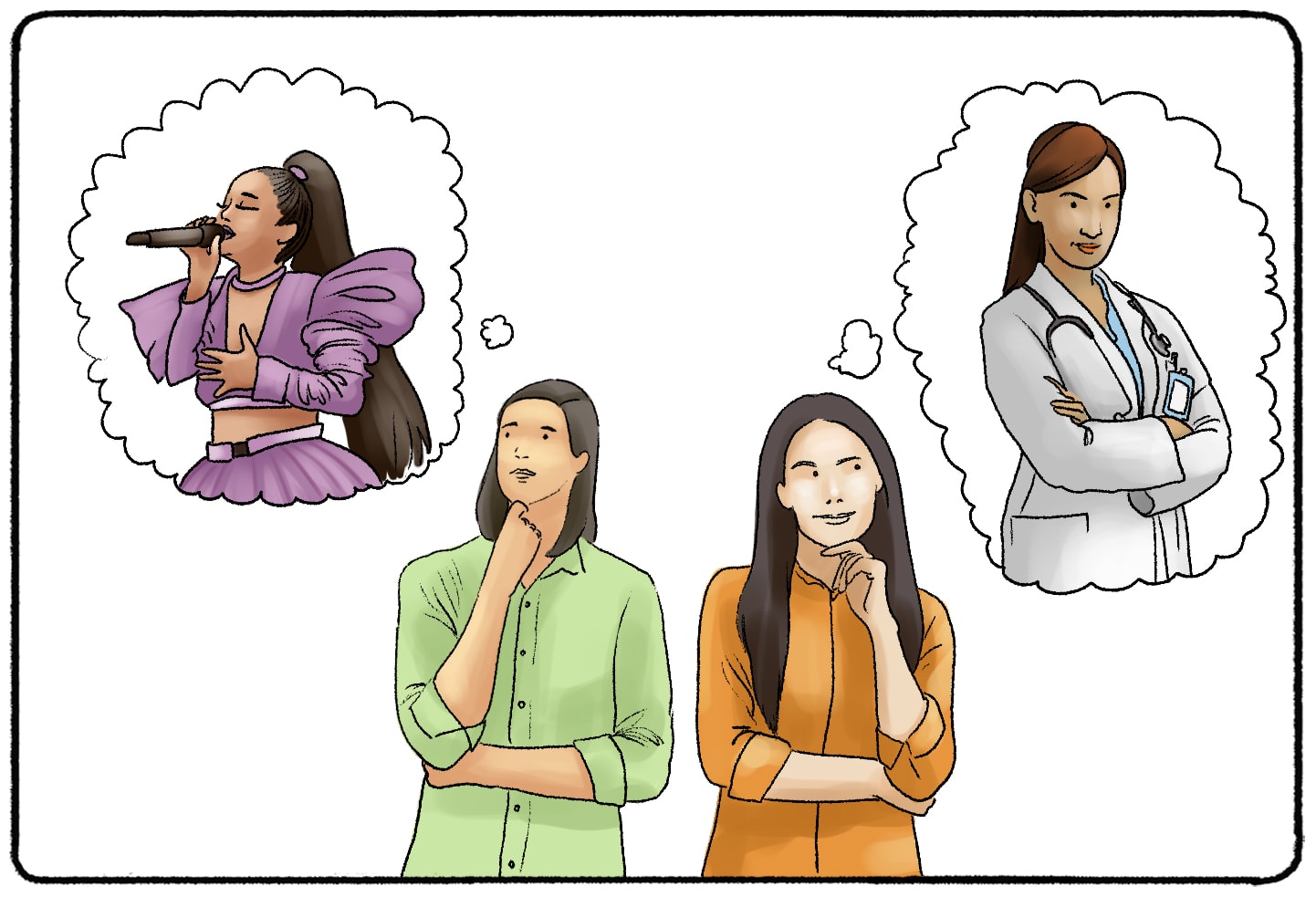In Milgram’s Obedience experiment, participants delivered deadly electric shocks simply because they were told. In the Stanford Prison Experiment, participants got violent with each other, even though they were in a simulation that was meant to last only a few days. Outside of social psychology experiments, we have witnessed people do unimaginable and questionable things.
The Social Impact Theory attempts to bring some clarity to this confusion.
Latané’s Social Impact Theory suggests that individuals can be sources or targets of social influence. It attempts to answer why we perform behaviors in certain situations. The source influences the target depending on various factors. Latané demonstrates these factors using an equation: i = f(S * I * N).
History of Social Impact Theory
In 1981, psychologist Bibb Latané created the idea of Social Impact Theory. If Bibb Latané’s name looks familiar to you, it’s because he is often credited as one of the psychologists who brought the Bystander Effect to light.

In Social Impact Theory, “i” is the impact. It’s a function of three variables: strength (s,) immediacy (i,) and the number of sources (n.) If any of these are significantly high or low, it will have a serious effect on the impact on the target. As you read about social impact theory, you are going to dive deeper into these factors and how they can impact someone’s behavior.
Social Impact Theory's Three Variables
Strength
Strength simply refers to the importance of the source. If the source appears to be an authority on a subject (or any subject,) the target is more likely to perform the behaviors that they suggest.
Two categories of strength determine a source’s impact: trans-situational strength and situation-specific strength.
Trans-situational Strength
The first type of strength exists no matter what the situation is. Trans-situational strength includes:
- The source’s age
- Physical appearance or other characteristics
- Held authority
- Perceived intelligence
- Etc.
Of course, society and culture may influence whether the source has trans-situational strength. In some countries, royalty has more strength than any other government figure. In other countries, the government leaders are the most important. Context will shape the source’s strength regardless of the situation.
Situation-specific Strength
This type of strength looks closer at the situation at hand and the behavior that the target is being asked to perform. Let’s say you were reading an article online about COVID in the early days of the pandemic. You see a quote from a medical doctor telling you to stay inside. You’re more likely going to listen to that doctor because they have authority in the situation.

Now let’s say you’re reading an article about fashion. You see a quote from a medical doctor telling you that the color pink is out, and the color orange is in. Not only are you unlikely to listen to the doctor’s advice, but you are also likely to be confused as to why this person is making a comment on something so out of their expertise.
Other factors under the umbrella of situation-specific strength include:
- Peer pressure
- Intoxication
- Political climate
Immediacy
Immediacy also makes a difference. But when psychologists talk about immediacy, they aren’t just talking about time.
Three forms of immediacy may impact a target: physical immediacy, temporal immediacy, and social immediacy.

Physical Immediacy
Immediacy may also be defined as “the quality of bringing one into direct and instant involvement with something.” If a source is physically close to a target, they are more likely to have an impact.
Think about this. If someone sends you an email asking you to answer a survey, you may take them up on it. (This is when strength really comes into play.) But if someone comes up to you at the grocery store and asks you to answer a survey, you are more likely to say yes (or at least respond to the person who is asking.)
Temporal Immediacy
Time also makes an impact on a target. A target is more likely to act immediately after a source asked them to do so. If the target waits five, ten, or twenty minutes, the likelihood that they are going to ask will decrease with time.
Marketers often consider this as they build campaigns or write ads. People are more likely to “buy now” rather than “buy at some point.” If you give potential customers too much time to weigh their options, they are less likely to act.
Social Immediacy
The last form of immediacy is social immediacy. This ties in with the strength of a source. If the source and target are “close,” the source is more likely to make an impact. The target may see themselves in the source because of the source’s race, gender, sexual orientation, religion, etc. The idea that we are more comfortable with people who are “like us” is not new in psychology. But the Social Impact Theory suggests that are also more likely to be influenced by people who are “like us.”
Number
Number is arguably the most important of these three factors. Even if a single source is not physically close or particularly “strong,” they will still be impactful if they are surrounded by many other sources.
One example of this comes from Stanley Milgram. Milgram is known for conducting one of the most controversial experiments in social psychology history. But not all of his experiments involved electric shocks. In 1968, Milgram asked a group of actors to stand on the street and stare up at the sky for 60 seconds at a time. As the actors did this, Milgram recorded how many passersby followed the gaze of the actors.
Milgram found that the number of actors influenced how many people followed their gaze. One person standing on the street and looking at the sky didn’t influence too many passersby. But a group of five or ten are more likely to turn some heads.
How much influence does that fifth or tenth source have on a target? Well, not a lot. The Psychosocial Law of the Social Impact Theory states that each subsequent source has less and less impact on the target. The third person to look at the sky is not going to be as impactful as the first or second. But they will still contribute to the overall impact.
Dynamic Social Impact Theory
Latané and his colleagues continued their research on social impact theory by “zooming out.” They looked at how different groups of people interact and influence each other. These observations, and the patterns within them, became the basis for dynamic social impact theory.
When compared to Latané’s larger body of work, social impact theory is seen as a “static” theory. The theory focuses on predicting how one person may be influenced on one topic or element by a larger group. Dynamic social impact theory looks at how this one person or group, who is influenced, may also influence a group or person as well. For example, celebrities influence the media, and media influences celebrities. The common people influence politicians and politicians influence the common people. This reciprocity is considered in dynamic social impact theory.
What Is Dynamic Social Impact Theory?
Dynamic social impact theory (DSIT) describes how groups create culture. Latané and colleagues picked up on four patterns that they believe have an impact and shape culture among groups. These four patterns are clustering, correlation, consolidation, and continuing diversity. At the heart of culture, the theory suggests, is communication between people
What are these four patterns, exactly? Let’s explore.
Clustering
Clustering is the presence of regional differences in attitudes, behaviors, and preferences. People influence other people who are close to them. For example, people in the United States are more likely to drink coffee in the morning to wake themselves up. People in the United Kingdom prefer tea. People in Austin might reach for a breakfast taco in the morning, while people in New York City prefer to order bagels. The connections between food and drink preferences and their regional locations happen due to clustering. This makes sense. If you are not sure what to have for breakfast, you are likely to check out what is being ordered by people around you, rather than people across the globe.
Correlation
When you spend time around a group of people, the group tends to adopt a similar mindset and perspective. As the group forms and opinions are shared, you all start to convince each other to believe the same things. We see this often in political parties. When a group of people belongs to a political party, they are more likely to carry all the beliefs of that party. This may happen because they only listen to commentators from that party, or are not exposed to the opposing side’s argument.
Consolidation and Continuing Diversity
Cultures change. The beliefs that Americans have had on same-sex or interracial marriage, for example, have changed over time. In this way, the people influence the politicians, and politicians influence the people. Consolidation (and continuing diversity) are two patterns that address how groups of people change.
These two processes are typically at odds with each other. Consolidation describes the minority influence giving way to the majority influence. The majority “takes over” the minority influence until it is largely eradicated. This doesn’t always happen completely. In many cases, minority groups within a larger culture remain isolated but alive. That isolation allows them to hold onto their minority influence. This is continuing diversity.
Minority opinion can also “take over” majority opinion.
The Importance of Communication in DSIT
As mentioned before, communication is central to all of these patterns. Without communication, culture would remain stagnant. Communication isn’t just two neighbors having a conversation over their fences. Political signs on front lawns are communication. Storefronts advertising “the best bagels in Brooklyn” are communicating. Recalling moments in regional history is communication. Communication may be intentional or unintentional, but either way, it can shape culture and the attitudes of people within a group.
This perspective made social impact theory and DSIT significant ideas of their time. If communication can have such a big impact on culture and majority opinion, then scholars might have a better idea of how large swaths of people can be influenced to meet certain goals.
How Is Social Impact Theory Reductionist?
"Reductionist" theories attempt to simplify very complicated topics in psychology. Many critics of social impact theory believe that it is reductionist. Strength, immediacy, and number of sources do not cover every factor that goes into decisions or behaviors. There may be other factors at play. Credibility, the target’s ability to perform a behavior, and the actual behavior may also influence whether or not someone performs a behavior. But despite this criticism, Social Impact Theory is still important when thinking about the impact a person can have on another.
